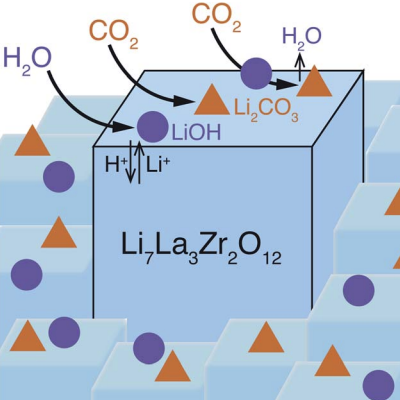Abstract
Understanding the reactivity of ubiquitous molecules on complex oxides has broad impacts in energy applications and catalysis. The garnet-type Li7La3Zr2O12 is a promising solid-state electrolyte for lithium(Li)-ion batteries, and it readily reacts with H2O and CO2 when exposed to ambient air. Such reactions form a contamination layer on Li7La3Zr2O12 that is detrimental to the battery operations. The strong interactions of Li7La3Zr2O12 with H2O and CO2, however, make Li7La3Zr2O12 a promising support to catalyze H2O dissociation and CO2 adsorption. Here, using first-principles calculations, we investigate the adsorption and reactions of H2O and CO2 on a Li7La3Zr2O12 surface. We show that H2O reacts through the exchange of proton and Li+ and produces metal hydroxide species. At high H2O coverage, half of the H2O molecules dissociate while the other half remain intact. CO2 reacts with the Li7La3Zr2O12 surface directly to produce carbonate species. We clarify that the individual reactions of H2O and CO2 with Li7La3Zr2O12 are more thermodynamically favorable than the co-adsorption of H2O and CO2. Finally, we demonstrate that low temperature and high partial pressure promote the reactions of H2O and CO2 with Li7La3Zr2O12. For energy storage application of Li7La3Zr2O12, our study guides processing conditions to minimize surface contamination. From a catalysis point of view, our findings reveal the potential of using complex oxides, such as Li7La3Zr2O12 as a support for reactions requiring H2O dissociation and strong CO2 adsorption.
